- Home
- David McCullough
The Pioneers Page 2
The Pioneers Read online
Page 2
Jefferson had since backed off from his position on slavery, having decided not to risk his political “usefulness” by maintaining such a stand. Further, by this time he had resigned his seat in Congress and departed for France to serve as the new American ambassador.
The plan set forth now at the Bunch of Grapes was to form an association or company to purchase from the government lands in Ohio and establish a first settlement there. A “very pleasing description” of the western country was provided by both Generals Putnam and Tupper. Manasseh Cutler, too, took an active part in the discussions. He had read nearly all that had been published of the writings of early French explorers and like others had been moved especially by descriptions of the land and the river by St. John de Crèvecoeur.
It is, without doubt, the most fertile country, with the most varied soil, the best watered, and that which offers to agriculture and commerce, the most abundant and easy resources, of all those which the Europeans have ever discovered. . . .
Crèvecoeur also described the experience of giving oneself up to the current of the Ohio River. “This sweet and tranquil navigation appeared to me like an agreeable dream.” (In a book he was soon to publish, Notes on the State of Virginia, Thomas Jefferson referred to the Ohio as “the most beautiful river on earth,” though, like Manasseh Cutler, he had never seen it.)
Full agreement at the Bunch of Grapes gathering was reached with no difficulty and in the days that followed further details were seen to. It was to be called the Ohio Company of Associates and Rufus Putnam was to be its chairman. A fund of a million dollars would be raised. No one could purchase less than one share, or more than five. Payment for each share would be primarily the face value of the certificates held by the veterans, plus $10 in gold or silver. The cash raised by the $10 payments was to cover the company’s operating expenses.
That the Ohio Company was also, apart from its noble intentions, a venture in land speculation went without saying. Those founders taking part at the Bunch of Grapes were to receive generous compensation. Rufus Putnam and Manasseh Cutler, for example, were each to receive four shares, or 4,692 acres of land.
Major Winthrop Sargent, another surveyor who had been to Ohio, was named secretary of the company, and Manasseh Cutler was chosen to negotiate with the Continental Congress in the purchase of the land. He was also to have a say in the enactment of a new Ordinance, whereby Congress would establish how the new states were to be laid out, and, importantly, the conditions under which they were to enter the Union. Such an ordinance was essential, for without it no purchase could be arranged. As would be said, “What would homes be worth to New England men without good government?”
That a national constitution had still to be resolved by the summer of 1787 meant there was as yet no president of the United States, only a Congress to deal with.
It was intended that this ordinance, now called the Northwest Ordinance, should stipulate that in the whole of the territory there would be absolute freedom of religion and particular emphasis on education, matters New Englanders considered fundamental to a just and admirable society.
Most importantly, there was to be no slavery. In the plan for the creation of a new state northwest of the Ohio River, the proposition put forth by Rufus Putnam and others at the time of the Newburgh Resolution, the total exclusion of slavery was an essential.
As would be observed by historians long afterward, the Northwest Ordinance was designed to guarantee what would one day be known as the American way of life.
Manasseh Cutler was to be the spokesman for the “Ohio cause” on the scene with the Congress in New York. The word “lobbyist” had yet to come into use. Rather he was the “agent” assigned to win congressional approval, and no fitter or more capable agent could have been selected.
His enthusiasm for the whole undertaking seemed to compound by the week. “The more I contemplate the prospect,” he wrote to Winthrop Sargent, “. . . the more I feel myself inclined to take an active part in carrying on the settlement and to be one of the first emigrants.” He was already contemplating the number of foreign vegetables that might thrive in land so rich.
II.
The day of his departure being a Sunday—“Lord’s Day,” as he liked to say—the Reverend Cutler preached a sermon before bidding goodbye to his wife and family and heading off “southward” to Cambridge, Boston, Providence, Rhode Island, and beyond, rolling along in his horse and buggy, making thirty to thirty-five miles a day and, to judge by his daily journal entries, in grand spirits.
He was bound first for New York, where the Congress sat, then Philadelphia, where for the past month the Constitutional Convention had been meeting in secret sessions. Crossing into Connecticut, he made a brief stop at the family farm in Killingly to see his father and found all well, his father, at age eighty, in better health than he expected, still able to help bring in the hay.
At Middletown, the traveling pastor was the guest of General Samuel Holden Parsons, one of the directors of the Ohio Company. A Harvard graduate, attorney, and noted officer in the Revolution, Parsons had traveled to the Ohio country only the year before as one of the commissioners appointed by Congress sent to the Northwest to negotiate a treaty with the Indians. He could speak from experience about the Ohio River, the great reach of the wilderness, the fertility of the soil. He and Cutler talked for the better part of a day. In addition, Parsons provided Cutler with still more letters of introduction.
At New Haven, he stopped again, this time to call on the president of Yale, the Reverend Ezra Stiles, a tiny sparrow of a man who, like Cutler, had enormous interest in practically everything.
It had been years since Cutler had been back to his alma mater and Stiles, happy to show him about, led a campus tour, introducing him to faculty and students, showing him the library and a collection of apparatus for the study of science. When Stiles insisted Cutler stay for a midday dinner with his wife and four daughters, Cutler could not resist. “I sent for my trunk,” he wrote, “and showed the Doctor and his lady, and the young ladies, my botanical apparatus and books, with which they were all highly pleased, having never seen anything of the kind before.” The previous day en route he had collected a number of flowers, all still perfectly fresh in his botanical box. With these in hand, he proceeded to deliver a short lecture on fructification, separating the parts at the same time, all to the delight of his audience. Only a call to dinner ended the performance.
Cutler could not have enjoyed the day more, but when urged to spend the night, he declined. He was on a mission and must keep on his way.
The roads were “very bad,” or “excessively bad.” He worried about his horse. A tavern at Fairfield, Connecticut, was “miserable, dirty.” He wrote of crossing King’s Bridge (“small, very narrow, and badly built”) onto New York Island and of seeing the ruins of British encampments and fortifications on both sides of the road on his way down to the city, as well as the ruins of Fort Washington, Fort Independence, and other fortifications built by the Americans.
By mid-afternoon Thursday, July 5, having covered 302 miles in twelve days, he arrived at the Plow and Harrow in New York and from there, wasting no time, he set off to deliver his letters of introduction.
From that point on things moved rapidly. The days that followed were as full as any he had known. He was everywhere, busy every hour, meeting or conferring with, or being hosted by one figure of importance or influence after another. In his business with Congress he regarded success “a duty.”
The morning of July 6, he went to New York’s City Hall to deliver his introductions to several members of Congress. At eleven o’clock he climbed the spacious stairs to the Congress Chamber on the second floor. At the time only eight of the thirteen states were represented by delegates.
A member from Virginia, Colonel Edward Carrington, greeted Cutler and introduced him to other members to whom Cutler delivered his “petition” for purchasing land for the Ohio Company and proposed the terms and
conditions of purchase. A committee of five was then appointed to agree on the terms and report to Congress.
He had made a good start, as no doubt he sensed. His manners in particular impressed three of the five members who were southerners. Never before, they said, had they seen such qualities in a northern man.
That the one who had come to persuade the members of Congress to accept a proposal of such monumental scale was neither a commercial proponent nor politician, but a well-mannered figure of high learning and culture, as well as a man of the cloth, was in itself a matter of considerable interest and importance. Clearly he was to be taken seriously.
In the days that followed, he dined in style several times, starting at the home of General Henry Knox, once a Boston bookseller, now secretary of war. Already an investor in the Ohio Company, Knox had great influence among veterans and was fervently urging Congress to act. Both the general and Madam Knox, as she liked to be called, with their love of lavish hospitality, had become quite large. (Secretary Knox weighed approximately 325 pounds.) Cutler described her as “gross” and thought her way of doing her hair, piled a foot high on top of her head, far from attractive.
But at a dinner hosted by an English social lion, Sir John Temple, the consul general of Great Britain, he was delighted to find Lady Temple “the greatest beauty, notwithstanding her age, I ever saw,” as happily he recorded in his journal, and then went on about her “soft but majestic air” and smiles that “could not fail of producing the softest sensibility in the fiercest savage.” One would suppose her to be no more than twenty-two, he wrote, when in fact she was forty-four and already a grandmother.
Attired as usual in clerical black, the Massachusetts pastor remained as courtly and socially active as always and filled his diary with each day’s events and observations on those he was meeting. Such effort as he devoted to the diary alone would have been enough in itself to tire most people. Yet he was also faithfully writing home to his wife, Mary, and depending greatly on repeated word from her, as he would continually during times away from her for years to come.
On the afternoon of July 9 he went again to climb the stairs to the Congress Chamber and in the course of much discussion made his case. This time, however, the session did not go well. What exactly was said, he did not record, only that they “debated on terms but were so wide apart that there appears little prospect of closing a contract.” With the meeting ended, several members of the committee were “polite enough” to point out to him the splendors of the great room, its fine furnishings, the grand, full-length portrait of George Washington, and drapery that “infinitely exceeds anything of the kind I ever saw before.”
Clearly he had much work to do.
Earlier that same day he had made a most important call on the geographer of the United States, a military engineer and surveyor of long experience on the western frontier, Thomas Hutchins, to discuss the best possible site for settlement on the Ohio River. That afternoon they met again.
A veteran of the French and Indian War, Hutchins had laid out Fort Pitt at Pittsburgh, where the Monongahela and the Allegheny Rivers meet to form the Ohio. Later, in 1766, he had conducted a hydrographic survey down the Ohio, on an expedition led by the well-known Indian trader George Croghan. A great number of Shawnees and Delawares went too, the entire party with baggage filling seventeen canoes. They traveled the whole length of the ever-winding river, more than 1,000 miles from Pittsburgh to the Mississippi, with the result of the first published survey describing the river’s depths, currents, bordering hills, and bottomlands.
More recently, Hutchins had been in charge of several surveys of the Ohio frontier under the protection of a military escort. He knew the territory as did very few white men and, as Manasseh Cutler learned, he had no hesitation about voicing his opinions on the subject. “He gave me the fullest information . . . and advised me, by all means, to make our location on the Muskingum, which was decidedly, in his opinion, the best part of the whole of the western country.”
The great trees of the forests at the confluence of the Ohio and Muskingum would not only provide timber aplenty for houses and boat building, but were a sure sign of fertile soil. Further, a federal fort, Fort Harmar, had now been established close by and the native population in the vicinity was comparatively small, two highly important advantages.
Thomas Hutchins’s advice was to be decisive.
The great Puritan leader John Winthrop, on board the ship Arbella, in 1630, on his way with the first Pilgrims to settle in Massachusetts, had famously declared, “For we must consider that we shall be as a city upon a hill.” By all evidence, the Reverend Manasseh Cutler had decided where in the Ohio country the new City upon the Hill was to be located.
On July 10, he dined with an English immigrant, William Duer, who had distinguished himself as a member of the Continental Congress during the Revolution and later became involved in a number of commercial and financial projects whereby he had become quite wealthy. He lived in the style of a nobleman. “I presume he had not less than fifteen different sorts of wine at dinner, and after the [table] cloth was removed,” Cutler wrote. Also present were Winthrop Sargent, who had come on to New York to work with Cutler, and another from Massachusetts named Samuel Osgood, who had recently been appointed one of the Board of Treasury.
To what extent Cutler discussed his conversation with Thomas Hutchins about the ideal location for settlement, if at all, is not known, but it would seem unlikely he could have kept Hutchins’s opinions to himself. In any event, Duer, Sargent, and Osgood were all to play considerable parts in what followed.
Congress by then had come to an agreement on the form of government for the western territory and drawn up a bill, a copy of which was sent to Cutler, and with leave for him to make any remarks he wished and propose any amendments, which he proceeded to do that same afternoon of July 10.
That done, he decided the time had come for a visit to Philadelphia, to pay calls on Benjamin Franklin, Dr. Benjamin Rush, and several other notables in the fields of science and medicine. There was, to be sure, the expectation also of meeting and conversing with those members of Congress taking part in the Constitutional Convention in session there.
Early the next morning, he was on the road again.
Keeping his horse and buggy at a steady clip, covering ninety-five miles in just two days, he found himself “a little fatigued” by the time he arrived and checked in at the Indian Queen, an elegant Philadelphia inn on Third Street between Market and Chestnut. His third-floor room provided a broad view of the Delaware River and New Jersey beyond. A servant brought him tea and he was quite happy to have no plans for the evening.
But no sooner did he hear about the number of members of the Constitutional Convention staying in the house than his fatigue vanished and he “very agreeably” spent the evening meeting and conversing with a half dozen or more of considerable importance, including James Madison and George Mason of Virginia, Charles Pinckney of South Carolina, and Alexander Hamilton of New York, who, like Henry Knox, was already a stockholder in the Ohio Company, with no immediate interest in settling in the west, but great interest in it as a speculative venture. Not until one in the morning did Cutler retire.
He was to spend only two days in Philadelphia, but he had arrived just as a summer heat spell had broken and cooled the city. He also managed to pack more into his time even than in his days in New York, and from the many pages he filled in his journal, from his descriptions of so much that he saw and of the eminent figures he met and conversed with, the visit was like nothing he had ever experienced.
He breakfasted the first day with Elbridge Gerry of Marblehead, Massachusetts, one of the signers of the Declaration of Independence and a member of the Constitutional Convention, then toured the city with a noted physician, Gerardus Clarkson, covering twenty miles in a handsome four-wheeled, open carriage pulled by a pair of “very large and fine” horses.
He and Clarkson called on another signe
r of the Declaration of Independence and the most notable of Philadelphia physicians, Dr. Benjamin Rush, then moved on to meet the celebrated portrait painter Charles Willson Peale at the museum Peale had created. It was the first of its kind in America combining both art and natural history, and far beyond anything Manasseh Cutler had ever seen or even imagined.
One particular part [he wrote] is assigned to the portraits of the principal American characters who appeared on the stage during the late revolution, either in the councils or armies of their country. . . . I fancied myself introduced to all the General Officers that had been in the field during the war, whether dead or alive, for I think he had every one, and to most of the members of the Congress and other distinguished characters.
In another part of the vast room was a great array of natural “curiosities” collected by Peale—all manner of shells, turtles, frogs, toads, lizards, water snakes—in addition to a variety of wild animals and birds of almost every species in America. What amazed Cutler most was that they were all real. It was hard to imagine Noah himself could have boasted a better collection.
From the Peale Museum, the tour moved on to the State House—Independence Hall—which Cutler thought “richer and grander in style” than any public building he had ever seen. Proceeding to the Mall outside, they confronted the city’s prison, the one experience of the day Cutler did not care for. He thought the building sufficiently elegant. It was “its unsavory contents” he found objectionable. In the warmth of the July morning all windows were open.
Your ears are constantly insulted with their Billingsgate language, or your feelings wounded with their pitiful complaints. Their long reed poles, with a little cap of cloth at the end, are constantly extended over into the Mall, in order to receive your charity, which they are incessantly begging. And if you refuse them, they load you with the most foul and horrid imprecations.

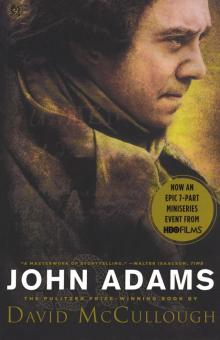 John Adams
John Adams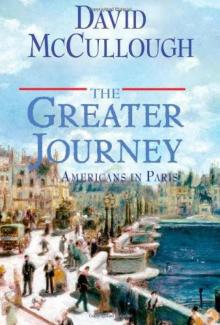 The Greater Journey: Americans in Paris
The Greater Journey: Americans in Paris 1776
1776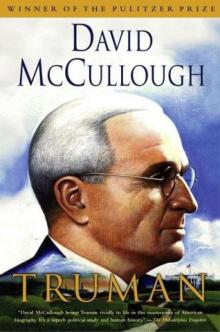 Truman
Truman The Pioneers
The Pioneers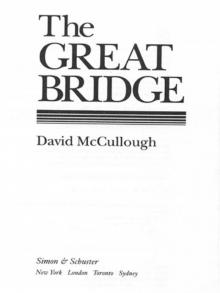 The Great Bridge: The Epic Story of the Building of the Brooklyn Bridge
The Great Bridge: The Epic Story of the Building of the Brooklyn Bridge The American Spirit
The American Spirit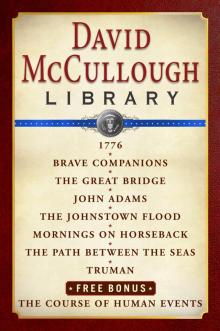 David McCullough Library E-book Box Set
David McCullough Library E-book Box Set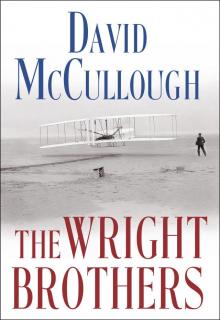 The Wright Brothers
The Wright Brothers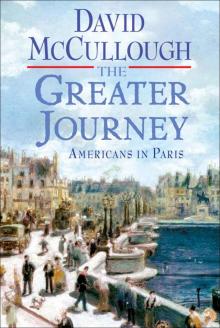 The Greater Journey
The Greater Journey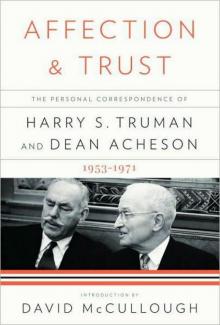 Affection and Trust: The Personal Correspondence of Harry S. Truman and Dean Acheson, 1953-1971
Affection and Trust: The Personal Correspondence of Harry S. Truman and Dean Acheson, 1953-1971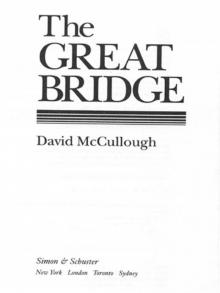 The Great Bridge
The Great Bridge